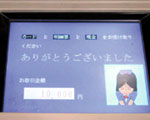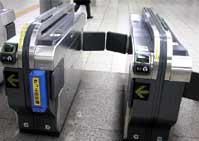|
Recently we had an email discussion with a reader on how Japanese interface with technology differently than other cultures. It turned into quite an interesting conversation, and in the process we learned that the reader, Ajay Revels (ajrevels@earthlink.net), was a San Francisco-based software usability consultant planning a trip to Japan to explore culture and technology issues more. Her month-long stay in Japan, she says, was fueled by a need to learn more about the current state of product design for the Japanese mobile computing market. In addition, she wanted to study the habits, questions, and social interactions of Japanese mobile phone users. We asked her to share with us the impressions she gathered during her trip -- nothing like a fresh gaijin viewpoint to remind us how different Japan really is. -- The Editors
MY FAVORITE THINGS
After spending a month living among the Japanese people, I learned first of all the value of social pliability and personal restraint. The answer to the question, "Can't we all just get along?" is yes, with a resounding bow. What really stunned me, though, was to learn that Japanese machines are not exempt from having to get along with everyone else, too. I'm a lifelong admirer and student of Japanese literature, movies, and Buddhist architecture, but I managed to fall in love with two more things: the tranquility permeating even the busiest Japanese cities, and the friendliness of Japanese machines. Both, I realized later, are closely related.
 FRIENDLY MACHINES FRIENDLY MACHINES
Everywhere I went, I ran into friendly technology and machines. They helped me in airports, in the subways and train stations, on the sidewalks, in grocery stores, in shopping malls, and even inside homes and hotels. The technology surprised me because it really seemed to fit the rhythms, expectations, and habits of the human beings around it. Machines treated people very well, and they seemed to be treated well in return. They demonstrated respect, they were clean, they conserved space, and, above all else, they went about their business in a quiet and calm manner.
Japanese machines never yelled at me. They didn't blast their horn, single me out with alarms, or tell me, Hey! Bonehead! Can't you see that the ticket goes in this way? Just step away from the gate and no one will get hurt. No. Instead they apologized, they offered a solution, asked permission, made cute little beeps, and even expressed regret. They never made me feel like it was my fault. And, as if that weren't enough, they had to nerve to make me laugh.
SUBWAYS AND TRAINS
Is it normal to bond with a train? Well I don't care if it isn't, because I spent three days bracing for the brake screech that never came. Subway trains produced less noise than the average American microwave oven and rolled along in a quick manner without tossing me around in transit or throwing me to the floor when stopping. The seats were even heated! Did I mention that they were covered in a velvet material? The only thing missing was a foaming mug of hot chocolate and a chair massage!
 TRAIN GATES TRAIN GATES
As I was passing through a train gate, someone behind me had trouble with her ticket and couldn't get through. But instead of buzzing in loud alarm, the gate simply turned on a red light, returned the ticket, apologized, and kept its flaps closed (thank goodness they don't use those annoying fork-shaped Halloween-inspired turnstiles). The station attendant rushed over, apologized, took the ticket, and placed it through the machine himself. Of course the gate thanked the lady, but you knew that already, didn't you?
 ZIPPY THE CAR ZIPPY THE CAR
Traffic resembled schools of tiny square fish swimming upstream. I burst out laughing when I got a good look at my first mini-vehicle car and truck. They have the distinct feeling of being dear little machines ready to grant your every wish. These cars, trucks, and family vans are cute, zippy, and raring to go. In a Rottweiler car world, they're your average Jack Russell Terrier. They're extremely compact, fit through narrow alleyways, park in non-existent spots, produce little road noise, and are well muffled. I bet they chase balls when no one is looking.
PARKING MACHINES
Behind my hotel was a white shoebox-shaped building about two cars deep and five cars wide, which looked to me like a car repair shop. A very tall repair shop, that is. All day I'd see cars drive up, stop in front, and be left behind. I began to get curious. I'm sure the very nice attendant will always remember the day that American woman smacked her forehead in disbelief. Sky Park turned out to be a vertical parking lot. Cars are driven onto numbered steel slots, like buckets on a Ferris wheel, and hoisted, smoothly, into the air. To retrieve a car, the attendant punches the "bucket" number into his computer and the Ferris wheel turns until that "bucket" reaches the bottom floor. Voila! He stops the machine at the bottom, gets into your car and backs it out. Some parking machines have rotating floors that turn cars so that they face forward in the driveways. As if that wasn't amazing enough, it was practically noiseless, too.
 KEITAI CULTURE KEITAI CULTURE
I found it fascinating to watch how people carried their cellphones, or keitai, and how they handled the calls. On trains, women often held the phone in one hand and applied makeup with the other, all the while keeping an eye on the display screen. Phones that led a business life-style were accessorized with gold or silver wrist straps and discreet jewelry or charms. Men didn't decorate their phones, for the most part, but were more likely to wear them around their necks. In shopping areas, teenagers and college-age students frequently wandered around, phone in hand -- waiting for "the call."
 THE HANDSETS THE HANDSETS
I stood outside a typical phone boutique and examined each and every keitai on display. I popped them open, I pulled on the antennas, I pushed all the buttons. These puppies were lightweight, playful, and easy to figure out -- the ultimate gab machines. Desire was growing in my heart. I thought about my Samsung flip-phone back home. Tiny by American standards, it was still heavy, missed calls frequently, and had never offered to buy me something from a vending machine. To top it all off, the only "fashion" accessory I could buy back home was a black leather case. Yawn.
MY BRIEF EXPLORATION OF Japanese technology and machines raised a zillion questions that I hope to find answers to some day. After interacting with one polite machine after another, I wondered, How can this be? Where is it going? Why are US machines so bulky, so noisy, and so rude by comparison? Do rude machines exist in Japan? Where are they? What kind of jobs do they perform? Would a rude machine seem like a failed design to its creators? And what, finally, would be the ultimate friendly machine? Something (someone?) developed from 10101010101 rather than genetic code? I dunno. The possibilities boggle the mind.
So, in the words of my favorite square-jawed machine,
"I'll be back."
Photographs by Ajay Revels and Christopher Arnold
|


 FRIENDLY MACHINES
FRIENDLY MACHINES  TRAIN GATES
TRAIN GATES ZIPPY THE CAR
ZIPPY THE CAR KEITAI CULTURE
KEITAI CULTURE THE HANDSETS
THE HANDSETS


